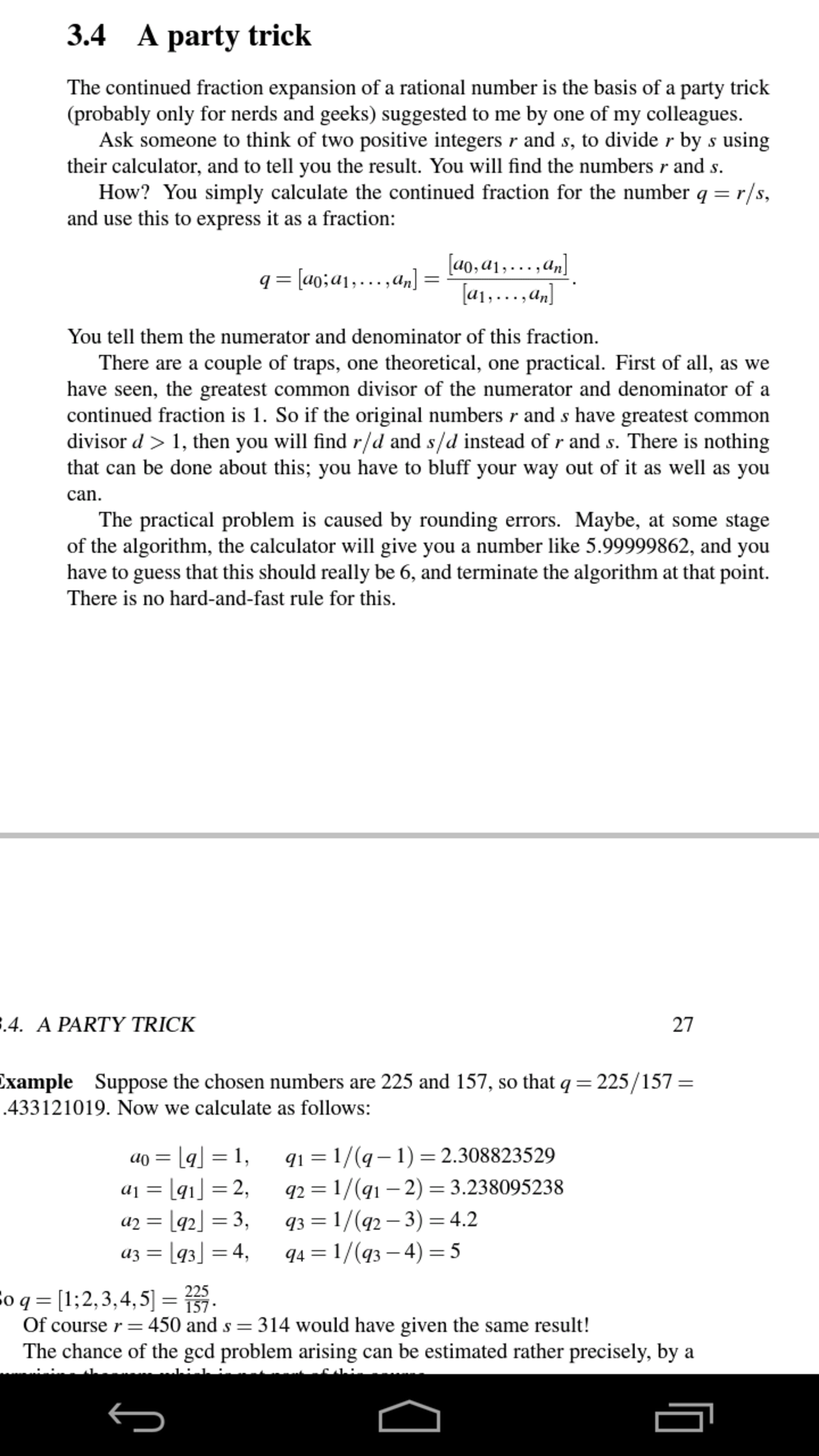Oh boy!, here comes the Soothsayer
I am thinking of two numbers, one a three digit number, and the other a two digit number. Their division gives me the result 6 . 0 3 1 9 1 4 8 9 4 (which is accurate to the tenth place of decimal).
Find the sum of the two numbers.
Clarification: The two numbers are positive integers and co-prime.And you have to find the smallest possible value of such numbers.
This problem is a part of the set All-Zebra
The answer is 661.
This section requires Javascript.
You are seeing this because something didn't load right. We suggest you, (a) try
refreshing the page, (b) enabling javascript if it is disabled on your browser and,
finally, (c)
loading the
non-javascript version of this page
. We're sorry about the hassle.
1 solution
What are you saying here?
- What is party trick?
- You have not demonstrated that the answer is unique. You have only found one possibility for numbers satisfying the condition.
- In the problem, by "there division" did you mean "Their division"?
Log in to reply
Sir I read this in a PDF, where if the result of a division is given then it could be found out through this method, and this fraction is unique as I have checked.
Here is the snapshot of the PDF I read.

And I by mistake typed "there" instead of "their", I am correcting it.
Log in to reply
"Party trick" refers to "This is a trick that you can use at a party to show off to your friends". It is not a standard reference that people would understand.
E.g. Another party trick could be "If you give me a number, I can tell you the remainder when divided by 9", which is done by just adding up all of the digits.
Point 2 is still valid.
Solution (+1).
Log in to reply
Thank you Samara :)
Log in to reply
I think I m the first to get this one right ;)
Log in to reply
@Samara Simha Reddy – Ya, you are the first one :)
Log in to reply
@Abhay Tiwari – You are great. How come you find such questions, I m able to solve but I m unable to post questions of level 5.
Log in to reply
@Samara Simha Reddy – Ha ha, no I am not that great, besides I've seen you posting a lot of good questions. And I made this Question myself, I was reading a chapter on continuous fraction, and I saw this Party trick, and came up with my original problem. Samara, even I am not able to post questions of level 5. :(
@Samara Simha Reddy – I think I spent around 20 - 25 minutes to solve this problem. Finally got it right.
Log in to reply
@Samara Simha Reddy – How did you solve?, exhaustion method?
Log in to reply
@Abhay Tiwari – Nope. I to used Party Trick method. Actually it was my sister who told about this method and the way of solving. So i solved it and got it right. ;)
Log in to reply
@Samara Simha Reddy – I guess your sister is a great mathematician. :)
Log in to reply
@Abhay Tiwari – Yeah. She does all sort of sums.
@Abhay Tiwari – I don't know that the name of this method is 'Party Trick'. I came to know only after seeing the solution. ;)
I am afraid that I can't quite parse this solution due to the grammar and style. Would it be possible to be copyedited?
This problem can be solved through "Party Trick"
let's call the given number a 0 , which we got after division. i.e. a 0 = 6 . 0 1 3 1 9 1 4 8 9 4 .
Now we apply Party trick.
[ a 0 ] = 6 . . . . . . . . . . . . . . . . . . . . . . . . . . . . . . . . . . . . . . . . . . . . . . . . . . . . . . . a n d a 1 = a 0 − [ a 0 ] 1 = 3 1 . 3 ˉ
[ a 1 ] = 3 1 . . . . . . . . . . . . . . . . . . . . . . . . . . . . . . . . . . . . . . . . . . . . . . . . . . . . . a n d a 2 = a 1 − [ a 1 ] 1 = 3
This methods End when we get an integer.
Now we apply the integral parts of all the value we got in the continued fraction like this
Let the fraction be Y, then Y = [ a 0 ] + [ a 1 ] + [ a 2 ] 1 1
Now substituting the values, we get: Y = 6 + 3 1 + 3 1 1 = 9 4 5 6 7
Now answer= 5 6 7 + 9 4 = 6 6 1